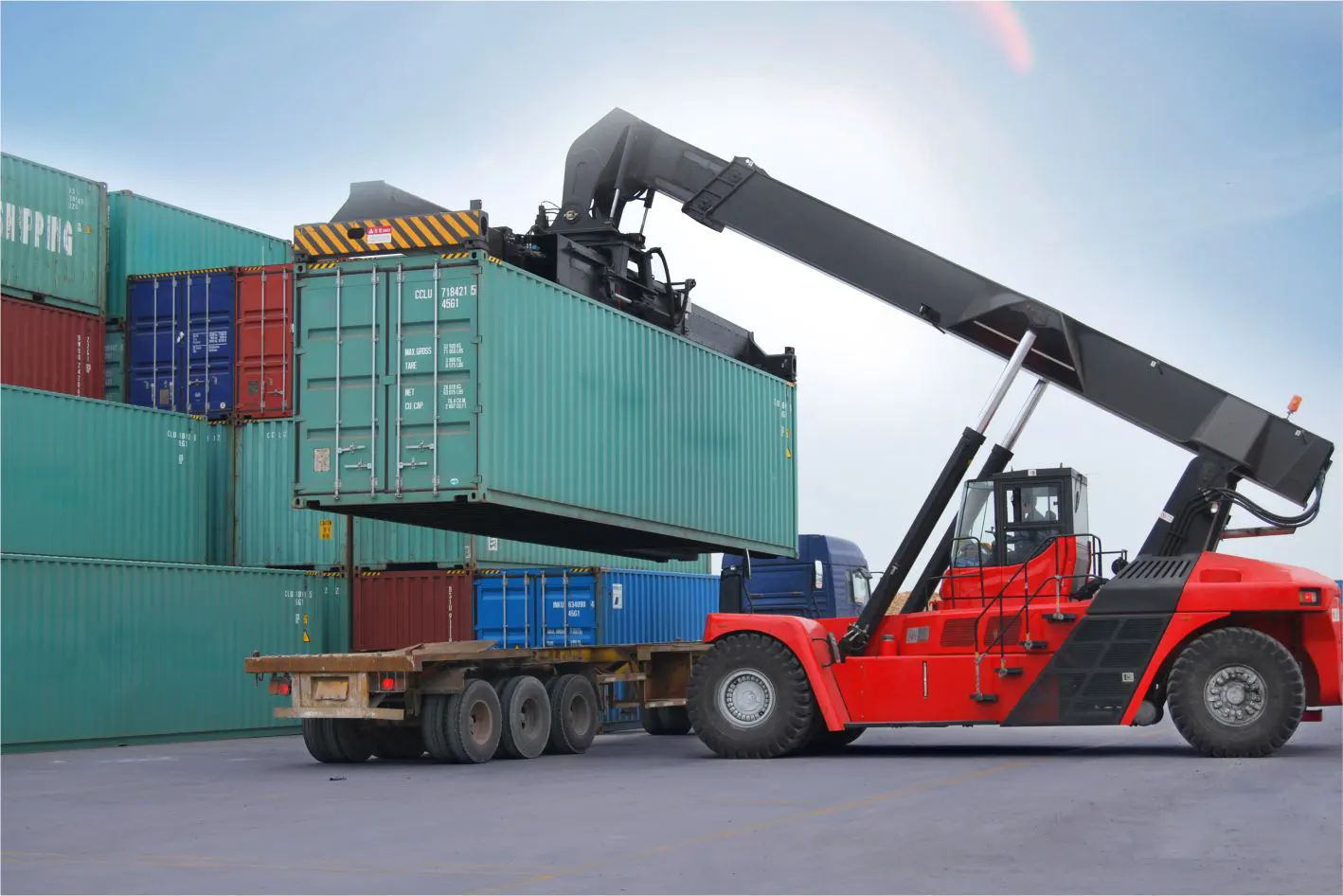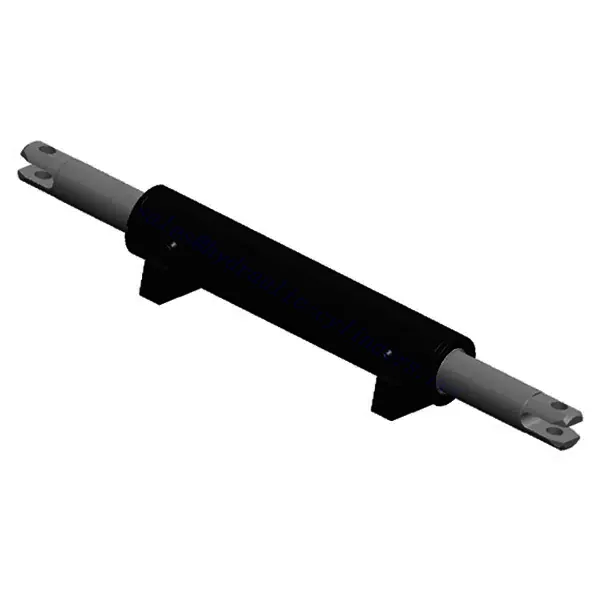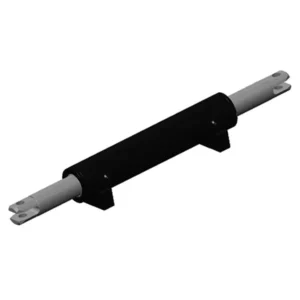Reach Stacker Steering Cylinder
Reach Stacker Steering Cylinder
The reach stacker steering cylinder is a vital hydraulic component designed to optimize control and maneuverability of reach stackers in material handling operations. This specialized cylinder enables smooth and precise steering, allowing operators to navigate tight spaces and handle heavy loads with ease. With its exceptional features, robust construction, and reliable performance, the reach stacker steering cylinder revolutionizes the efficiency and productivity of material handling processes.
The reach stacker steering cylinder is a game-changer in material handling operations, offering enhanced control, maneuverability, and efficiency. With its exceptional steering capabilities, high load-bearing capacity, and optimal energy efficiency, this cylinder empowers operators to navigate reach stackers with ease, increasing productivity and safety. By following the recommended usage methods and implementing regular maintenance practices, companies can maximize the performance, longevity, and reliability of their reach stacker operations. The reach stacker steering cylinder is a valuable investment for any material handling fleet, enabling precise control, efficient maneuvering, and seamless operations in the competitive material handling industry.
Reach Stacker Steering Cylinder Key Characteristics:
- Enhanced Steering Control: The reach stacker steering cylinder offers exceptional steering control, allowing operators to navigate reach stackers precisely. It ensures smooth and responsive steering, facilitating accurate positioning of containers and efficient maneuvering in confined spaces. Operators can confidently navigate complex layouts, improving productivity and reducing the risk of accidents or damage.
- High Load-bearing Capacity: This cylinder is designed to withstand heavy loads encountered in material handling operations. It is engineered with sturdy materials and robust construction, enabling it to handle the rigors of demanding applications. The Reach Stacker Steering Cylinder ensures stability and reliability, even when maneuvering large containers or carrying substantial loads, enhancing safety and performance.
- Optimal Efficiency: The reach stacker steering cylinder contributes to overall operational efficiency by minimizing energy loss during steering maneuvers. It features advanced hydraulic technology that reduces internal friction, improving energy efficiency and reducing power consumption. This efficiency translates into cost savings and prolonged equipment lifespan.
Reach Stacker Steering Cylinder Parameter:
| Product Name | Reach Stacker Luffing Cylinder |
| Features: | Realize the adjustment of the direction of the crane’s tires |
| Bore diameter: | 80mm~200mm |
| Rod diameter: | 60mm~100mm Stroke≤9500mm |
| Pressure: | Maximum 25MPa |
| Applications: | Reach Stacker |
Reach Stacker Cylinder Application:

Usage Method Of Reach Stacker Steering Cylinder:
Steering Control: To utilize the Reach Stacker Steering Cylinder effectively, follow these steps:
a. Engage the reach stacker’s hydraulic system and ensure the hydraulic pressure is within the recommended operating range.
b. Utilize the reach stacker’s steering controls, such as a steering wheel or joystick, to direct the vehicle’s movement.
c.The reach stacker steering cylinder will respond to the operator’s input, translating it into smooth and precise steering motions.
d. Monitor the reach stacker’s direction and adjust the steering input to achieve the desired path or positioning.
How Hydraulic Cylinders Are Made?
Hydraulic cylinders are commonly manufactured using a systematic process involving several key steps. While the specifics may vary depending on the manufacturer and cylinder design, the following is a general overview of how hydraulic cylinders are made:
- Design and Engineering:
- The process begins with the design and engineering phase. Engineers and designers create detailed specifications, considering load capacity, stroke length, operating pressure, and environmental conditions.
- Material Selection:
- Once the design is finalized, suitable materials are selected based on the application requirements. Common materials used for hydraulic cylinders include high-strength steel for the cylinder barrel, piston, and rod, and seals and gaskets made from elastomers or other suitable materials.
- Cylinder Barrel Production:
- The cylinder barrel is typically manufactured through a process called honing. Honing involves precision machining the inner surface of the barrel to achieve a smooth and precise finish. This ensures optimal sealing and reduces friction during operation.
- Piston and Rod Production:
- The piston and rod are typically machined from high-strength steel. CNC or other machining techniques are used to achieve precise dimensions and tolerances. The piston may have grooves for seals, and the rod is often hardened and chromed for durability and resistance to wear.
- Assembly:
- The assembly process involves fitting various components together to create the hydraulic cylinder. This includes inserting seals, bearings, and other necessary parts into the barrel, attaching the piston and rod, and securing them with retaining rings or bolts.
- Surface Treatment and Coating:
- Depending on the application and environmental conditions, the hydraulic cylinder may undergo surface treatments and coatings to enhance corrosion resistance and durability. This can include electroplating, painting, or applying specialized coatings.
- Testing and Quality Control:
- Once the assembly is complete, hydraulic cylinders undergo rigorous testing to meet quality and performance standards. This may include pressure, leakage, and functional testing to verify proper operation and reliability.
- Final Finishing and Packaging:
- After passing quality control checks, the hydraulic cylinders undergo final finishing processes, such as cleaning, deburring, and cosmetic enhancements. They are then carefully packaged for shipment or storage, ready to be installed in hydraulic systems.
工厂的能力和产能:
(1) 装配
我们拥有一流的自主研发装配平台。液压油缸生产车间拥有 4 条半自动提升油缸装配线和 1 条全自动倾斜油缸装配线,设计年生产能力 100 万支。特种油缸车间配备了各种规格的半自动清洗装配系统,设计年生产能力 20 万只,并配备了知名数控加工设备、加工中心、高精度油缸加工专用设备、机器人焊接机、自动清洗机、油缸自动装配机、自动喷漆生产线等。现有关键设备 300 多台(套)。设备资源的优化配置和高效利用,保证了产品的精度要求,满足了产品的高质量需求。


(2) 机加工
加工车间配备了定制的斜轨车削中心、加工中心、高速珩磨机、焊接机器人及其他相关设备,可加工最大内径 400 毫米、最大长度 6 米的气缸管。

(3) 焊接

(4) 油漆和涂料
配备中小型圆筒自动水性漆喷涂线,实现机器人自动上下料和自动喷涂,设计产能为每班 4000 件;
我们还拥有一条由动力链驱动的大型油缸半自动喷漆生产线,设计产能为每班 60 箱。


(5) 测试
我们拥有一流的检验设施和试验台,确保气缸的性能符合要求。

We are one of the best hydraulic cylinder manufacturers. We can offer comprehensive hydraulic cylinders. We also provide corresponding 农用齿轮箱. We have exported our products to clients worldwide and earned a good reputation because of our superior product quality and after-sales service. We welcome customers at home and abroad to contact us to negotiate business, exchange information, and 与我们合作!
参观我们的 VR 工厂
通过以下方式参观我们的 VR 工厂
叉车液压缸如何工作?
液压缸应用:



